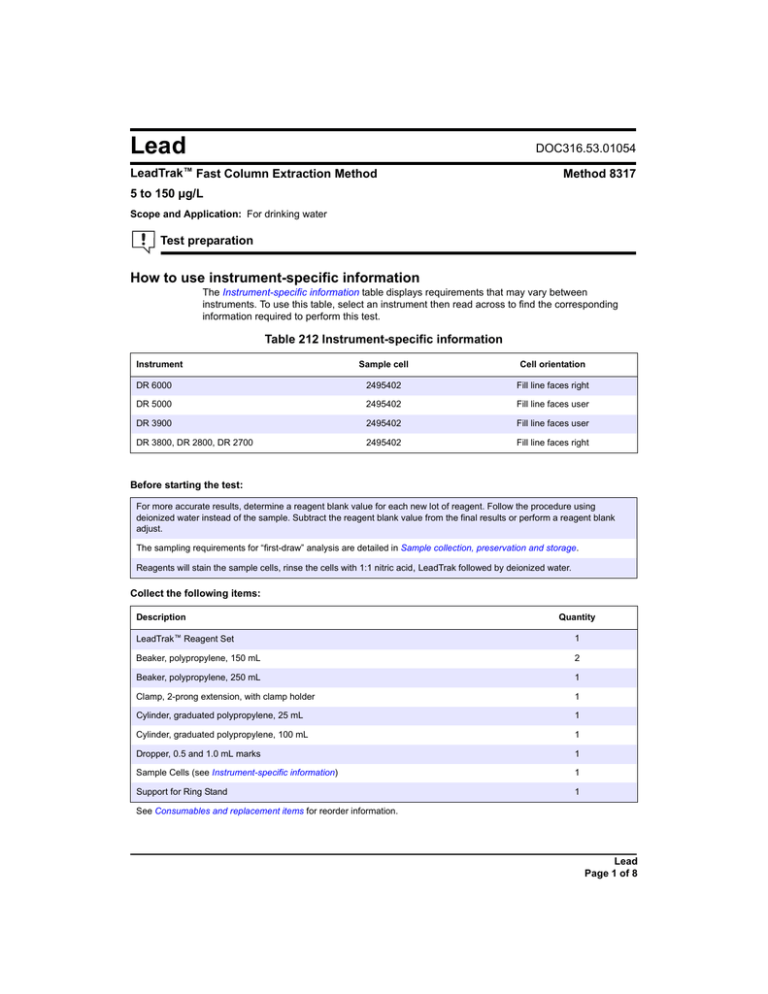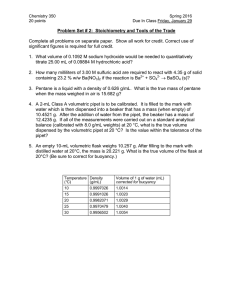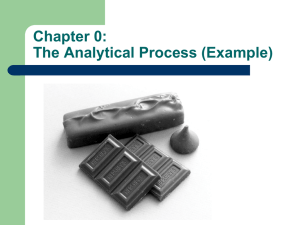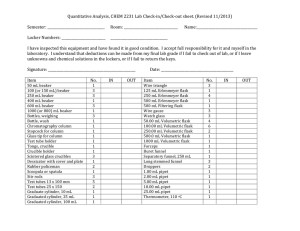
Lead, LeadTrak, 8317
Lead
DOC316.53.01054
LeadTrak™ Fast Column Extraction Method
Method 8317
5 to 150 µg/L
Scope and Application: For drinking water
Test preparation
How to use instrument-specific information
The Instrument-specific information table displays requirements that may vary between
instruments. To use this table, select an instrument then read across to find the corresponding
information required to perform this test.
Table 212 Instrument-specific information
Instrument
Sample cell
Cell orientation
DR 6000
2495402
Fill line faces right
DR 5000
2495402
Fill line faces user
DR 3900
2495402
Fill line faces user
DR 3800, DR 2800, DR 2700
2495402
Fill line faces right
Before starting the test:
For more accurate results, determine a reagent blank value for each new lot of reagent. Follow the procedure using
deionized water instead of the sample. Subtract the reagent blank value from the final results or perform a reagent blank
adjust.
The sampling requirements for “first-draw” analysis are detailed in Sample collection, preservation and storage.
Reagents will stain the sample cells, rinse the cells with 1:1 nitric acid, LeadTrak followed by deionized water.
Collect the following items:
Description
Quantity
LeadTrak™ Reagent Set
1
Beaker, polypropylene, 150 mL
2
Beaker, polypropylene, 250 mL
1
Clamp, 2-prong extension, with clamp holder
1
Cylinder, graduated polypropylene, 25 mL
1
Cylinder, graduated polypropylene, 100 mL
1
Dropper, 0.5 and 1.0 mL marks
1
Sample Cells (see Instrument-specific information)
1
Support for Ring Stand
1
See Consumables and replacement items for reorder information.
Lead
Page 1 of 8
Lead
LeadTrak Fast Column Extraction
Stored Programs
283 Lead, LeadTrak
Start
1. Select the test.
Insert an adapter if
required (see Instrumentspecific information).
Refer to the user manual
for orientation.
2. Fill a 100 mL plastic
graduated cylinder with
100 mL of the sample.
Pour the measured
sample into a 250 mL
plastic beaker.
3. Using a plastic 1mL
dropper, add 1.0 mL of
pPb-1 Acid Preservative
Solution to the sample and
swirl to mix.
4. Start the instrument
timer.
A two-minute reaction
period will begin.
If the sample has been
preserved previously with
pPb-1 Acid Preservative at
a ratio of 1.0 mL per 100
mL sample, omit steps 3
and 4.
Samples preserved with
Nitric Acid require steps 3
and 4.
5. When the timer
expires, use a second
1 mL plastic dropper to
add 2.0 mL of pPb-2 Fixer
Solution. Swirl to mix.
6. Mount a new Fast
Column Extractor in a ring
stand with a clamp. Place
a 150-mL plastic beaker
under the Extractor.
Field samples that have
been preserved with nitric
acid or samples that have
been digested may
exceed the buffer capacity
of the Fixer Solution. After
step 5, check the pH of
these samples and adjust
with 5 N Sodium
Hydroxide to a pH of 6.7–
7.1 before proceeding with
step 6.
A Fast Column Extractor is
included in the LeadTrak®
Reagent Set. A new
extractor is required for
each test.
Lead
Page 2 of 8
7. Soak the cotton plug
with deionized water and
compress it with the
plunger. Remove the
plunger. If the cotton plug
moves up the column,
push it back to the bottom
with a clean, blunt rod.
The cotton plug should fit
snugly against the inner
wall of the column.
8. Pour the prepared
sample slowly into the
center of the Column
Extractor. Wait for the
sample to flow through.
The sample solution
should flow relatively
slowly (2 drops per
second) through the
column.
Keep the level of the
sample solution just above
the cotton plug.
Lead
LeadTrak Fast Column Extraction (continued)
9. After the flow has
stopped, fully compress
the absorbent pad in the
Extractor with the plunger.
Discard the contents of the
beaker. Slowly withdraw
the plunger from the
Extractor.
The absorbent pad should
remain at the bottom of the
Extractor when the
plunger is removed. If the
cotton plug moves up the
column, push it back to the
bottom with a clean,
blunt rod.
13. Add the contents of
one pPb-5 Indicator
Powder Pillow to the
beaker and swirl
thoroughly to mix.
10. Place a clean, dry 150
mL beaker under the
Extractor. Using a 25 mL
plastic graduated cylinder,
add 25 mL of pPb-3 Eluant
Solution to the Extractor.
11. Allow the Eluant
Solution to drip slowly from
the Extractor.
After the flow has stopped,
fully compress the
absorbent pad.
Keep the level of the
eluent solution just above
the absorbent pad.
14. Pour 10 mL of solution
into a sample cell.
15. Start the instrument
timer.
A two-minute reaction
period will begin.
12. Using a 1 mL plastic
dropper, add 1.0 mL of
pPb-4 Neutralizer Solution
to the beaker. Swirl
thoroughly to mix and
proceed immediately to
step 13.
16. When the timer
expires, insert the sample
cell.
The solution will turn
brown.
Lead
Page 3 of 8
Lead
LeadTrak Fast Column Extraction (continued)
Zero
Read
17. ZERO the instrument.
The display will show:
0 µg/L Pb
18. Remove the sample
cell and add 3 drops of
pPb-6 Decolorizer Solution
to the cell. Swirl vigorously
to mix
19. Insert the sample cell
into the cell holder.
20. READ the results in
µg/L Pb.
Interferences
Interference studies were conducted by preparing a known lead solution of 25 µg/L as well as the
potential interfering ion. The ion was said to interfere when the resulting lead concentration
changed by ± 10%. Samples containing levels exceeding these concentration values may be
diluted 1:1 and analyzed. Multiply the value obtained by a factor of 2 to determine the lead present
in the original sample.
To avoid contamination, do not use black rubber stoppers, black dropper bulbs and droppers with
inked graduations. Use the plastic droppers provided in the reagent set.
Acid-wash all glassware and plasticware to prevent sample contamination, especially if the
previous sample had a high lead level (see Apparatus and sample preparation).
The Extractor plunger may be reused for more than one test but should be rinsed with lead-free
water between uses.
Table 213 Interfering substances
Interfering substance
Aluminum,
Al3+
Interference level
0.5 mg/L
Ammonium, NH4+
500 mg/L
Barium, Ba2+
6 mg/L
Calcium, Ca2+
500 mg/L
Chloride,
Cl–
1000 mg/L
Copper, Cu2+
2 mg/L
Fluoride, F–
10 mg/L
Iron, Fe2+
2 mg/L
Magnesium, Mg2+
500 mg/L
Manganese, Mn2+
0.5 mg/L
Nitrate,
NO3–
Sulfate, SO42–
Zinc,
Zn2+
Lead
Page 4 of 8
1000 mg/L
1000 mg/L
1 mg/L
Lead
Apparatus and sample preparation
Because lead is very common to our environment, care must be taken to prevent sample
contamination. Follow these steps for greatest test accuracy:
•
Lead-free water is necessary to minimize sample contamination when rinsing apparatus or
diluting sample. The water may be either distilled or deionized. If the water is obtained from a
grocery store, verify the lead concentration is zero from the label. If the lead concentration is
uncertain, determine the lead concentration with the LeadTrak test.
•
Plastic or glass sample containers and lids may be checked for contamination by rinsing with 1
mL of pPb-1 Acid Preservative Reagent*. Add 100 mL of lead-free water. After 24 hours,
analyze this solution using the LeadTrak® test to confirm the absence of lead.
•
Rinse glassware used in this test with a small amount of dilute lead-free 0.1 N nitric acid or
pPb-1 Acid Preservative Reagent followed by rinsing with lead-free water.
•
pPb-5 Indicator may be rinsed from the glass sample cells with a few drops of pPb-1 Acid
Preservative Reagent or a small amount of dilute lead-free nitric acid.
•
Acidify solutions containing lead with Nitric Acid or pPb-1 to below pH 2 to prevent adsorption
of lead onto the container walls. See Sample collection, preservation and storage.
Sample collection, preservation and storage
•
Samples may be collected either from household pipes (point-of-use) or from water sources.
•
Preserved samples may be stored up to six months.
•
Each sample type typically requires different sampling procedures. Consult with the
appropriate regulatory agency for more information about specific sampling requirements.
Sampling for lead contamination in household pipes for point-of-use drinking water
•
The sample should be collected after sitting in pipes with no flow for a minimum of six hours.
•
Add 10 mL of pPb-1 Acid Preservative* to a one-liter bottle.
•
Turn on tap and collect exactly the first liter of water in the bottle containing acid preservative.
•
Cap and invert several times to mix.
•
After two minutes the sample is ready for analysis. Steps 3 and 4 are skipped in the analysis
procedure. Use 100 mL of this preserved sample directly in step 5.
Sampling for lead contamination from drinking water sources such as well water or water from main
supply lines
•
Add 10 mL of pPb-1 Acid Preservative* to a one-liter bottle.
•
Turn on the tap for 3–5 minutes or until the water temperature has been stable for 3 minutes.
•
Collect exactly one liter of water into the bottle containing the acid preservative.
•
Cap and invert several times to mix.
•
After two minutes the sample is ready for analysis. Steps 3 and 4 are skipped in the analysis
procedure. Use 100 mL of this preserved sample directly in step 5.
•
At least one liter should be collected to obtain a representative sample. If less than one liter is
collected, use 1 mL of pPb-1 Acid Preservative per 100 mL of sample.
•
If nitric acid is to be substituted for pPb-1 as a preservative or the sample is digested, the
buffering capacity of the pPb-2 Fixer Solution* may be exceeded. Adjust the sample pH to
6.7–7.1 pH with 5 N Sodium Hydroxide* after step 6.
* See Optional reagents and apparatus.
Lead
Page 5 of 8
Lead
Accuracy check
Standard additions method (sample spike)
Required for accuracy check:
•
10 mg/L (10,000 µg/L) Lead Standard Solution
•
TenSette Pipet and pipet tips
1. After reading test results, leave the sample cell (unspiked sample) in the instrument.
2. Select Options>More>Standard Additions from the instrument menu.
3. Accept the default values for standard concentration, sample volume and spike volumes. After
the values are accepted, the unspiked sample reading will appear in the top row. See the user
manual for more information.
4. Open the standard solution.
5. Use the TenSette Pipet to prepare spiked samples: add 0.1 mL, 0.2 mL and 0.3 mL of
standard to three 100 mL portions of fresh sample.
6. Follow the LeadTrak Fast Column Extraction test procedure for each of the spiked samples
starting with the 0.1 mL sample spike. Measure each of the spiked samples in the instrument.
7. Select GRAPH to view the results. Select IDEAL LINE (or best-fit) to compare the standard
addition results to the theoretical 100% recovery.
Standard solution method
Note: Refer to the instrument user manual for specific software navigation instructions.
Required for accuracy check:
•
Lead Standard Solution, 1000 mg/L or Lead Voluette® Ampule Standard Solution, 50-mg/L
as Pb
•
Lead-free water or Deionized water
•
100 mL Class A volumetric flask or 100-mL plastic volumetric flask
•
1.0 mL Class A volumetric pipet
•
TenSette Pipet and Pipet Tips
1. Prepare a 100 µg/L Lead standard solution as follows:
a. Pipet 1.0 mL of Lead Standard, 1000 mg/L, into a 100 mL volumetric flask.
b. Use a Tensette Pipet to add 0.2 mL of concentrated nitric acid to the flask
c. Dilute to the mark with lead-free deionized water.
d. Pipet 10.00 mL of this prepared solution into a 1 liter plastic volumetric flask.
e. Add 2.0 mL of nitric acid to the flask.
f.
Dilute to the mark with lead-free water.
g. Prepare this solution immediately before use.
OR
1. Prepare a 100 µg/L Lead Standard Solution as follows:
a. Use a Tensette Pipet to add 0.2 mL from a Lead Voluette® Ampule Standard Solution, 50
mg/L as Pb into a 100 mL plastic volumetric flask.
b. DIlute to volume with deionized water. Prepare solution immediately before use
Lead
Page 6 of 8
Lead
2. Use the standard solution in place of the sample. Follow the LeadTrak Fast Column Extraction
test procedure.
3. To adjust the calibration curve using the reading obtained with the 100-mg/L Standard
Solution, select Options>More>Standard Adjust from the instrument menu.
4. Turn on the Standard Adjust feature and accept the displayed concentration. If an alternate
concentration is used, enter the concentration and adjust the curve to that value.
Method performance
Program
Standard
283
50 µg/L
Sensitivity
Concentration change
per 0.010 Abs change
Precision
95% Confidence Limits of
Distribution
Pb2+
45–55 µg/L
Point of Curve
Concentration
Entire curve
4 µg/L Pb2+
Pb2+
Summary of method
Acid soluble lead, as Pb2+, in a potable water sample is first concentrated on a Fast Column
Extractor. The lead is then eluted from the Extractor and determined colorimetrically with an
indicator. Test results are measured at 477 nm.
Consumables and replacement items
Required reagents
Description
Quantity/Test
Unit
Catalog number
LeadTrak™
1
20/pkg
2375000
Quantity
Unit
Catalog number
108044
Reagent Set
Required apparatus
Description
Beaker, polypropylene, 150 mL
2
each
Beaker, polypropylene, 250 mL
1
each
108046
Clamp, 2-prong extension
1
each
2114500
Clamp Holder
1
each
32600
Cylinder, graduated polypropylene, 25 mL
1
each
108140
Cylinder, graduated polypropylene, 100 mL
1
each
108142
Dropper, 0.5 and 1.0 mL marks
1
20/pkg
2124720
Sample cell, 10 mL square, matched pair
2
2/pkg
2495402
Support for Ring Stand
1
each
56300
Unit
Catalog number
Recommended standards and apparatus
Description
Flask, volumetric, polypropylene, 1000 mL
each
2099553
Flask, volumetric, polypropylene, 100 mL
each
2099542
Lead Standard Solution, 1000 mg/L as Pb
100 mL
1279642
Lead Standard Solution, 50-mg/L 10 mL Voluette® Ampules
16/pkg
1426210
Lead Standard Solution, 10 mg/L
25 mL
2374820
Nitric Acid, ACS
500 mL
15249
Lead
Page 7 of 8
Lead
Recommended standards and apparatus (continued)
Description
Unit
Catalog number
each
1970001
Pipet Tips, for TenSette Pipet 1970001
50/pkg
2185696
Pipet Tips, for TenSette Pipet 1970001
1000/pkg
2185628
each
1451535
Pipet,
TenSette®,
0.1 to 1.0 mL
Pipet, volumetric, Class A, 1.00 mL
Pipet Filler, safety bulb
each
1465100
Pipet, volumetric, Class A, 10.00 mL
each
1451538
4L
27256
Water, deionized
Optional reagents and apparatus
Description
Unit
Catalog number
pPb-1 Acid Preservative Reagent
236 mL
2368531
pPb-2 Fixer Solution
43 mL
2368655
1L
245053
Sodium Hydroxide, 5.0 N
FOR TECHNICAL ASSISTANCE, PRICE INFORMATION AND ORDERING:
In the U.S.A. – Call toll-free 800-227-4224
Outside the U.S.A. – Contact the HACH office or distributor serving you.
On the Worldwide Web – www.hach.com; E-mail – techhelp@hach.com
© Hach Company, 2007, 2010, 2012. All rights reserved. Printed in the U.S.A.
HACH COMPANY
WORLD HEADQUARTERS
Telephone: (970) 669-3050
FAX: (970) 669-2932
Edition 7






